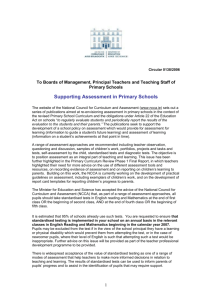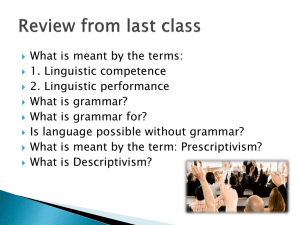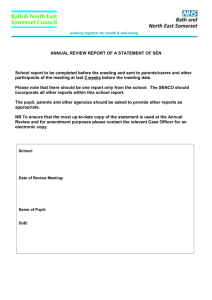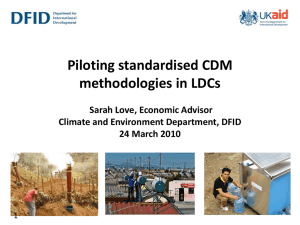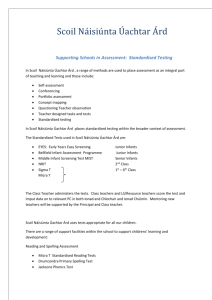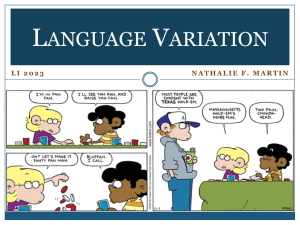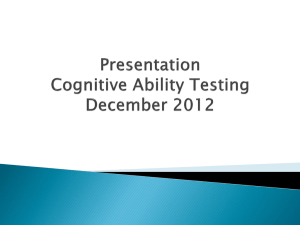National Assessment Policy and Standardised Testing in Schools
advertisement
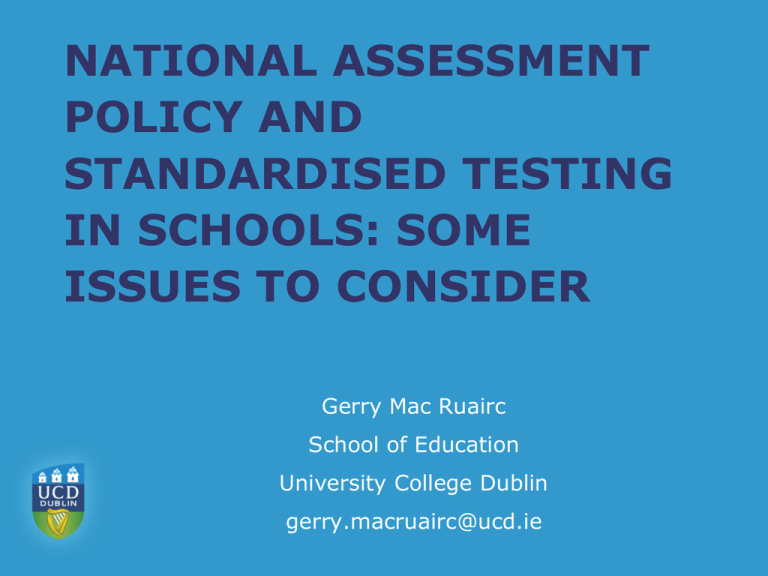
NATIONAL ASSESSMENT POLICY AND STANDARDISED TESTING IN SCHOOLS: SOME ISSUES TO CONSIDER Gerry Mac Ruairc School of Education University College Dublin gerry.macruairc@ucd.ie Overview • Four core themes – The broad context and the accountability agenda – Some issues to be considered in the implementation of current policy – some limitations – Bias in testing – Exploring alternatives The broad context: Some key themes • Increased testing at higher states = improved attainment • Impact of an outcome driven neo- liberal agenda • Globalisation and the increasing economisation of education policy (Lingard 2010) • Education as a valid part of a comparative and competitive market driven area of growth PISA, PIRLS, TIMS, Sunday Times … • Policy makers know best – and base their knowledge on undeclared sources • A what works approach – transferrable epistemologies and policy borrowings Some discourses often silenced • Standardised testing – a contested terrain • Patterns of results - we know this already! • Language ideologies underpinning curriculum, textbooks and pedagogy • Language, culture and subtractive schooling Rising stakes – imperatives for testing in Ireland • Historically practice varied in schools • Circular 8/99- link between standardized test results and resources • Part of the evidence base for tuairisci scoile and WSE • Increased emphasis on results in evaluations • Policy development on mandatory testing and informing parents • Collation of test results – National Literacy Strategy • What is next? National Literacy Strategy / Circular The strategy and the circular • Circular 0138/2006 required all schools to implement standardised testing in English reading and mathematics at two points in the primary cycle. • Now: English-medium schools the period May/June for all students in 2nd, 4th and 6th classes with effect from 2012 onwards • You are requested to ensure that standardised testing is implemented in your school on an annual basis in the relevant classes beginning in May/June 2012 (to facilitate valid comparisons between schools and types of schools) • Principal teachers in primary schools are required to report annually aggregated assessment data from standardised tests to the board of management of their schools • Primary schools will be required to report aggregate standardised test results to the Department of Education • The template for reporting to boards of management (included in the appendix) will be used to collect the data – format not yet decided The tests in context • Tests should be used like dangerous drugs – handle with care (Spolsky, 1981) • Tests still retain a dominant position in terms of assumed objectivity- enjoys enormous support and trust on the part of the public and public/state institutions – firmly embedded in systems • Evidence reveals that what results is a more intensive stratification on the basis of class and race rather than what the rhetoric suggests • Currently more questions are asked about ‘test takers’ than about the construction of tests and ‘test makers’ (Willie 2001). TESTING: Some issues to consider • High stakes - Impact on practice: international evidence – Teach to the test – (Anagnostopoulos, 2005; McNeil 2000; Zigo, 2001; Lam and Bordignon 2001; Alexander 2009 Darling Hammond 2010). – Impoverished curriculum (UK Primary Curriculum Review, 2009) - Wash back effect – narrows the curriculum – Avoidance of risk taking and innovative practice (Williams & Ryan, 2000, Stobart, 2008). – Negative impact particularly notable in schools succeeding in connecting curricula and teaching to the realities of students’ cultures, backgrounds and economic conditions (McNeil, 2000, Hursh 2008). IMPACT Rising stakes Narrowing curriculum and pedagogy Testing and views about good teaching • Teachers begin to view themselves and their effectiveness on the basis of student of outcomes on tests – impacts practice related to testing – 43% already speak of high correlation between test results and perceptions of effectiveness (Rogerson 2011) • DES funded UCD study on effective models of practice – very strong messages related to what makes a good teacher within the profession • Main findings: • Reflective Practitioner, • Effective Planning and Management of Learning, Social and Moral Dimension, • Love for children/young people, • Passion for Teaching and Learning • Important that these are not negated in what is considered it be a good teacher in the future. Communication results to parents? Not too good just 1 in reading You have a 2 in reading Not sure what it means but she said you have a STEN score of 3 in reading – that’s not that good She said our Amy only has a 2 /10 in reading She got a 6/10 that’s the top of the class – it’s not that high She got a 2 in reading I thought she was great at reading – but she only got a 1/10 BIAS • Despite considerable scholarship on bias in testing there is a significant level of a ‘denial of bias’ among many policy makers with respect to standardised tests. • Broadly speaking test bias can occur in – the design of test items and the language register of the test – the use that is made of the test results – in the manner in which the test is administered. AND – The manner in which the test is completed by children Administering the test • Test score pollution practices (Haladyna, Nolen and Haas 1991; Rogerson 2011) • One hundred and sixty primary school teachers completed the questionnaire; 28 were male (17.5%) and 132 were female (82.5%) • “I am aware of other teachers engaging in nonstandard practices to raise the scores their classes achieve 40% agreement • “Some teachers’ practices around standardised test administration and correction are a cause of concern for you” 30% agreement Table 1: Actions carried out by yourself or that you are aware other teachers have carried out in relation to standardised testing. 80.0% 70.0% 60.0% 50.0% 40.0% 30.0% Self Other Teacher 20.0% 10.0% 0.0% Gave an answer to a student Allowed extra time for test completion Encouraged students to redo/check an answer In the time Explained Noted common leading up to vocabulary from errors made by testing taught the English test teachers to topics knowing paper inform future that such would teaching be examined in the test Taught items Followed all time Left materials on from the test and view knowing administration that such instructions materials would exactly aid students in the test 16 BIAS: Some strategies used by students in test completion 1. Means the same as /is the correct word 2. Straightforward Guess: –Quick Pick –Eenie, meanie, miney, mo 3. Makes sense: attempts to locate context for the word in existing linguistic repertoire/ experience It makes sense or sounds right • Stark differences between socio-economic groups. • For working class children - little by way of familiar context for the language. • Fundamental misunderstandings about the meaning of word as a direct result of the particular context in which the child had previously experienced the word or part of the word. It makes sense- working class group Are dogs domestic animals? foreign/ friendly/ tame/ sensible Shelly: I picked friendly because domestic means clean from Domestos the bleach and clean …that’s good and so is friendly They were unable to subdue him. Quieten /rescue/assist/replace Jack: I put rescue ‘cause I thought subdue meant to like get him back. Peter: I thought he was stuck down the hole and you get him back. Jack: To subdue him back to your gang- yeah that’s it The Middle Class sense When the middle class child went to their linguistic repertoire they often found an appropriate context for the word Jill: Courteous kinda means nice… you know polite Emma: I don’t know why I know the meaning… I’ve heard it like loads of times before. Eire: I don’t know where… you read it in books. Kate: You hear it around the place. Rachel: I picked on the outskirts because I’ve heard the word before and I kinnda know what it means … well I do know what it means. Rachel: I put permission because they say … in some books they say like… he took off without his leave, another word for permission. it’s What are we testing? • The level of resonance between the language used in test items and the middle-class linguistic repertoire- the middle-class student in a notably privileged position in terms of the potential for higher levels of attainment on the test. • This high level of linguistic resonance permeates the whole test experience for the middle-class child, with the result that each of the strategies used, including simple guessing, have a great likelihood of success. • The testing experience for the working-class child on the other hand, is characterised by varying degrees of struggle with the linguistic challenges that the tests presents. • Only one dimension of the linguistic heterogeneity is tested. • Validating the dominant linguistic register and rewarding those who are immersed in this register for their success in acquiring literacy of their own linguistic world. Significant limitations as a mode of assessment • Specific issues for disadvantaged schools in terms of the broader asymmetrical patterns of distribution* (following slide) • In all cases the focus is too narrow and does not adequately capture the current practice in relation to literacy • However, their simplicity, presumed ‘objectivity’, the ‘validity’ of comparisons they give rise, render these a formidable force to reckon with So what do we do… • A systematic, reliable approach to capturing the work of the school across all dimensions of literacy practice. • Anecdotal is not enough; the legitimacy of the standard is too strong and too embedded • School wide development work needed here • System wide leadership from within the profession required • The NCCA document and beyond • Release the potential within schools to release the potential within the system in order to – celebrate the successes – identify and address the challenges within all school types schools in an authentic way Otherwise • Increasingly become more imprisoned by the regimes of testing • Continue to reproduce patterns of failure that can obscure real success stories • Impoverish the curriculum, particularly in disadvantaged schools • Narrow and reduce our expectations for the outcomes of schooling, for pedagogy within schools and for the education system more broadly

